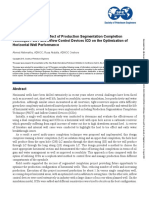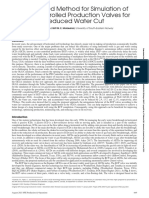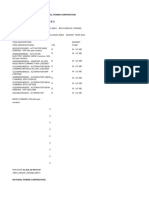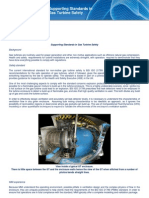IPTC IPTC-15336-PP Numerical Simulation of Hydraulic Fracturing in A Stacked Tight Gas Condensate Reservoir
IPTC IPTC-15336-PP Numerical Simulation of Hydraulic Fracturing in A Stacked Tight Gas Condensate Reservoir
Uploaded by
jimyCopyright:
Available Formats
IPTC IPTC-15336-PP Numerical Simulation of Hydraulic Fracturing in A Stacked Tight Gas Condensate Reservoir
IPTC IPTC-15336-PP Numerical Simulation of Hydraulic Fracturing in A Stacked Tight Gas Condensate Reservoir
Uploaded by
jimyOriginal Title
Copyright
Available Formats
Share this document
Did you find this document useful?
Is this content inappropriate?
Copyright:
Available Formats
IPTC IPTC-15336-PP Numerical Simulation of Hydraulic Fracturing in A Stacked Tight Gas Condensate Reservoir
IPTC IPTC-15336-PP Numerical Simulation of Hydraulic Fracturing in A Stacked Tight Gas Condensate Reservoir
Uploaded by
jimyCopyright:
Available Formats
IPTC IPTC-15336-PP
Numerical Simulation of Hydraulic Fracturing in a Stacked Tight Gas
Condensate Reservoir
Abdolrahim Ataei, Wong Tiong Hui, Keng Seng Chan, PETRONAS, Raymond Lau, Mei-Ee Yeap, Shell Sarawak
Bhd. (SSB)
Copyright 2011, International Petroleum Technology Conference
This paper was prepared for presentation at the International Petroleum Technology Conference held in Bangkok, Thailand, 1517 November 2011.
This paper was selected for presentation by an IPTC Program Committee following review of information contained in an abstract submitted by the author(s). Contents of the paper, as
presented, have not been reviewed by the International Petroleum Technology Conference and are subject to correction by the author(s). The material, as presented, does not necessarily
reflect any position of the International Petroleum Technology Conference, its officers, or members. Papers presented at IPTC are subject to publication review by Sponsor Society
Committees of IPTC. Electronic reproduction, distribution, or storage of any part of this paper for commercial purposes without the written consent of the International Petroleum Technology
Conference is prohibited. Permission to reproduce in print is restricted to an abstract of not more than 300 words; illustrations may not be copied. The abstract must contain conspicuous
acknowledgment of where and by whom the paper was presented. Write Librarian, IPTC, P.O. Box 833836, Richardson, TX 75083-3836, U.S.A., fax +1-972-952-9435
Abstract
Hydraulic fracturing is a well known practice to improve the well productivity especially in tight gas reservoirs. For gas
condensate reservoir, it can be applied to bypass the condensate bank that formed shortly after production start-up due to
pressure drop below the saturation pressure. However, benefits of hydraulic fracturing in multiple stacked reservoirs with low
initial gas saturations cannot be guaranteed. Unforeseen fracture propagation may result in premature water encroachment,
thus adversely impacting well productivity. In order to avoid this, proper fracture modeling is critical to assess the benefits of
hydraulic fracturing when dealing with relatively thin multiple stacked reservoirs.
This is the situations that exist in one of the gas condensate reservoirs located offshore Sarawak in Malaysia. This paper tries
to address the challenges that exist in such a marginal gas condensate field. Reservoir simulation including a hydraulic
fracture model was developed to simulate the condensate banking and fracture performance simultaneously. DST results
were also modeled accurately to estimate the actual condensate bank effect and to reflect it back into the full field simulation
model.
This paper shows how the lessons learnt from existing fractured wells, detailed modeling, and numerical simulation work can
be used to optimize development of such a marginal field. It addresses the stimulation challenges in a marginal gas
condensate green field.
Introduction
In this paper, we are addressing a tight gas condensate reservoir with 11 stacked sands separated by shale layers. The sand
thicknesses are between 10- 110 feet and follows hydrostatic pressure regime at shallow zones and is over pressured by 2000
psi in deeper sands. Core data shows wide range of permeability between 0.01-10 md in different part of hydrocarbon zones.
DST results are also shows a tight formation with average permeability in the range of 3-7 md within the tested zones.
Reservoir fluid analysis shows that the CGR is about 67-84 STB/MMSCF with CO2 content of 1% and H2S content of 1
ppm. Capillary pressure measurements show that a large part of the field is in transition zone. Figure 1(a) shows the
measured and also the modeled Pc data from available core samples. It results high water saturation within the hydrocarbon
sands as shown in Figure 1 (b).
As it can be seen there are several challenges exist in development of this field. These challenges are:
Stacked sands: The hydrocarbons are spreading in small to medium size compartments separated by shale layers. It
will impact the completion strategy especially when it comes to producing from sands with different flow regimes.
Condensate banking: The richness of reservoir fluid and the low permeability matrix can impact the gas production
forecast by condensate banking. This effect has studied using single well modeling.
Well stimulation: There is no doubt that without near wellbore productivity improvement, the low permeable sands
will not have an optimum well productivity. Hydraulic fracturing has been suggested to improve the well
deliverability in this field. However, it can be threaten seriously by early water break through due to the sand
thickness, close proximity to aquifer and high water saturation in the formation.
You might also like
- SPE 131582 Condensate Banking Phenomenon Evaluation in Heterogeneous Low Permeability ReservoirsDocument18 pagesSPE 131582 Condensate Banking Phenomenon Evaluation in Heterogeneous Low Permeability ReservoirsAdanenche Daniel EdohNo ratings yet
- AIPM BoilersDocument150 pagesAIPM Boilerspartha halderNo ratings yet
- CO2 Injection Into Depleted Gas ReservoirsDocument15 pagesCO2 Injection Into Depleted Gas ReservoirsbobcyliaoNo ratings yet
- Spe 148491 MSDocument15 pagesSpe 148491 MSsaeed65No ratings yet
- Production Performance of Gas Condensate Reservoirs - Compositional Numerical ModelDocument13 pagesProduction Performance of Gas Condensate Reservoirs - Compositional Numerical ModelJamalNo ratings yet
- Iptc 19824 MS PDFDocument6 pagesIptc 19824 MS PDFbu7amudNo ratings yet
- SPE 153022 A Workflow For Modeling and Simulation of Hydraulic Fractures in Unconventional Gas ReservoirsDocument11 pagesSPE 153022 A Workflow For Modeling and Simulation of Hydraulic Fractures in Unconventional Gas Reservoirstomk2220No ratings yet
- Spe 173450 MsDocument16 pagesSpe 173450 Ms9412ttjNo ratings yet
- Spe 172083 Ms CMG ModelDocument18 pagesSpe 172083 Ms CMG ModelDavidNo ratings yet
- 159340-MS-P - DMF FracDocument11 pages159340-MS-P - DMF FracKarrar AliNo ratings yet
- SPE-199074-MS Solving The Challenges of A Complex Integrated Production System in Camisea Field Using Novel Modeling TechniquesDocument16 pagesSPE-199074-MS Solving The Challenges of A Complex Integrated Production System in Camisea Field Using Novel Modeling TechniquesEfrain Alex Morales CaballeroNo ratings yet
- Investigate A Gas Well Performance Using Nodal AnalysisDocument15 pagesInvestigate A Gas Well Performance Using Nodal Analysisrafiullah353100% (1)
- SPE-174307-MS Optimization of Hydraulic Fracturing Design With Future EOR Considerations in Shale Oil ReservoirsDocument20 pagesSPE-174307-MS Optimization of Hydraulic Fracturing Design With Future EOR Considerations in Shale Oil ReservoirsDinda FasyaNo ratings yet
- SPE 167711 - Numerical - Simulation - of - Low - PermeabilityDocument30 pagesSPE 167711 - Numerical - Simulation - of - Low - PermeabilityPedroNo ratings yet
- Simulação de ResrvatoriosDocument8 pagesSimulação de ResrvatoriosLarissa RochaNo ratings yet
- Spe 173867 MsDocument11 pagesSpe 173867 Msfangzhou xuNo ratings yet
- SPE-198035-MS Chemical EOR Pilot Design Optimization Through Dynamic Reservoir CharacterizationDocument11 pagesSPE-198035-MS Chemical EOR Pilot Design Optimization Through Dynamic Reservoir Characterizationyogs6666No ratings yet
- Preprints201609 0007 v1Document14 pagesPreprints201609 0007 v1Medardo TorresNo ratings yet
- KPIM of GasCondensate Productivity - Prediction of Condensate Gas Ratio (CGR) Using Reservoir Volumetric BalanceDocument10 pagesKPIM of GasCondensate Productivity - Prediction of Condensate Gas Ratio (CGR) Using Reservoir Volumetric BalanceIrwan JanuarNo ratings yet
- IPTC 14008 Inclusions of Well-Test Interpretation and Sector Model Simulation Into A Full Field Model: An Integration Modeling ApproachDocument11 pagesIPTC 14008 Inclusions of Well-Test Interpretation and Sector Model Simulation Into A Full Field Model: An Integration Modeling Approachamramazon88No ratings yet
- SPE-174937-MS Optimizing Separation Efficiency of Produced Water Tanks by Installing CFD Designed InternalsDocument11 pagesSPE-174937-MS Optimizing Separation Efficiency of Produced Water Tanks by Installing CFD Designed InternalsSajad FalahNo ratings yet
- Spe 143438 MsDocument8 pagesSpe 143438 MsDIOSEMEL CASTRO TOLOZANo ratings yet
- Spe 175557 MSDocument12 pagesSpe 175557 MSabdulghaffar1991No ratings yet
- SPE 71546 A Systematic Approach in Deepwater Flow Assurance Fluid CharacterizationDocument12 pagesSPE 71546 A Systematic Approach in Deepwater Flow Assurance Fluid CharacterizationJessica CehNo ratings yet
- Aziz 2009Document8 pagesAziz 2009Amr HegazyNo ratings yet
- Practical Compartmental Model For Shale-Gas Production by Multiple-Fractured Horizontal Wells Considering Transport..Document27 pagesPractical Compartmental Model For Shale-Gas Production by Multiple-Fractured Horizontal Wells Considering Transport..Mbarouk Shaame MbaroukNo ratings yet
- SPE 88797 Determination of Recovery and Relative Permeability For Gas Condensate ReservoirsDocument11 pagesSPE 88797 Determination of Recovery and Relative Permeability For Gas Condensate ReservoirsmsmsoftNo ratings yet
- SPE-179013-MS Multifunctional Stimulation of Gas Wells Operating in Gas Cap Over A Depleted Oil ReservoirDocument16 pagesSPE-179013-MS Multifunctional Stimulation of Gas Wells Operating in Gas Cap Over A Depleted Oil ReservoirQaiser HafeezNo ratings yet
- SPE 144112 Application of Silicate/Polymer Water Shut-Off Treatment in Faulted Reservoirs With Extreme High PermeabilityDocument16 pagesSPE 144112 Application of Silicate/Polymer Water Shut-Off Treatment in Faulted Reservoirs With Extreme High PermeabilityQaiser HafeezNo ratings yet
- Numerical Modeling and Optimization of Condensate Banking Treatment in The Hydraulic-Fractured Shale Gas Condensate ReservoirDocument18 pagesNumerical Modeling and Optimization of Condensate Banking Treatment in The Hydraulic-Fractured Shale Gas Condensate ReservoirFredy Andres Narvaez BohorquezNo ratings yet
- SPE 122225 Gas Condensate Productivity Improvement by Chemical Wettability AlterationDocument12 pagesSPE 122225 Gas Condensate Productivity Improvement by Chemical Wettability AlterationGabriel EduardoNo ratings yet
- IPTC-22235-MS Foams To Control Slugging Issues in Pipeline - From Lab To SimulationDocument9 pagesIPTC-22235-MS Foams To Control Slugging Issues in Pipeline - From Lab To SimulationLuky HendraningratNo ratings yet
- SPE-160924-MS - To Develop The Optimum Field Development Plan For Condensate Well Using IPMDocument12 pagesSPE-160924-MS - To Develop The Optimum Field Development Plan For Condensate Well Using IPMHafiz AsyrafNo ratings yet
- A Case Study On The Effect of Production Segmentation CompletionDocument9 pagesA Case Study On The Effect of Production Segmentation CompletionSara Kamil Abd Al-RedahNo ratings yet
- Model Investigation of Low Salinity Brine Injection On Gas-Condensate Recovery in A Sandstone Reservoir Effect of Calcium and Sodium IonsDocument8 pagesModel Investigation of Low Salinity Brine Injection On Gas-Condensate Recovery in A Sandstone Reservoir Effect of Calcium and Sodium IonsInternational Journal of Innovative Science and Research Technology100% (1)
- Spe 198185 MSDocument16 pagesSpe 198185 MSosamaNo ratings yet
- Dinámica de Los Bancos de Condensados en Campos de Gas Condensado: Cambios en Las Relaciones de Condensado Producido A Gas.Document16 pagesDinámica de Los Bancos de Condensados en Campos de Gas Condensado: Cambios en Las Relaciones de Condensado Producido A Gas.Guadalupe RuizNo ratings yet
- Ganjdanesh, Treatement, Of, Water, And, CondensateDocument10 pagesGanjdanesh, Treatement, Of, Water, And, CondensateAllah BakhshNo ratings yet
- Energy Science Engineering - 2022 - Ma - Numerical Simulation On Gas Liquid Separation Characteristics in ADocument10 pagesEnergy Science Engineering - 2022 - Ma - Numerical Simulation On Gas Liquid Separation Characteristics in AThiago VicznevskiNo ratings yet
- Spe 205377 PaDocument16 pagesSpe 205377 PaKamal HamzahNo ratings yet
- Well Productivity in Gas Condensate and 80172Document14 pagesWell Productivity in Gas Condensate and 801721367031950% (2)
- SPE 182 - Robust Chemical EOR Modelling From Coreflood To Full Field Scale in A Brown Field, Offshore-Ghadami2016Document19 pagesSPE 182 - Robust Chemical EOR Modelling From Coreflood To Full Field Scale in A Brown Field, Offshore-Ghadami2016Elizabeth CanoNo ratings yet
- Angsi K StoneDocument9 pagesAngsi K StonerishitharanNo ratings yet
- Spe 147765 Advanced Chemical Water-Shutoff Treatments in Multilayer Gas Reservoirs: A Case Study Frompeciko Field, East Kalimantan, IndonesiaDocument12 pagesSpe 147765 Advanced Chemical Water-Shutoff Treatments in Multilayer Gas Reservoirs: A Case Study Frompeciko Field, East Kalimantan, Indonesiahade wantoNo ratings yet
- IPTC 16616 A Case Study: Innovative Open Hole Well Completion Provides Superior Results in Tight Gas Formation in Jilin District, ChinaDocument12 pagesIPTC 16616 A Case Study: Innovative Open Hole Well Completion Provides Superior Results in Tight Gas Formation in Jilin District, ChinaAmr HegazyNo ratings yet
- Feng2013 PDFDocument12 pagesFeng2013 PDFAmr HegazyNo ratings yet
- Build Up InformationDocument18 pagesBuild Up Informationjose luis pachecoNo ratings yet
- 10 1016@j Apenergy 2019 05 049Document14 pages10 1016@j Apenergy 2019 05 049xu yanNo ratings yet
- Spe 131787Document15 pagesSpe 131787downloader1983No ratings yet
- SPE 153388 Modeling Condensate Banking in Lean Gas Condensate ReservoirsDocument13 pagesSPE 153388 Modeling Condensate Banking in Lean Gas Condensate ReservoirsFredy Andres Narvaez BohorquezNo ratings yet
- Otc 28348 MSDocument12 pagesOtc 28348 MSHossein TashaNo ratings yet
- SPE 118173 Using A Dynamic Coupled Well-Reservoir Simulator To Optimize Production of A Horizontal Well in A Thin Oil RimDocument8 pagesSPE 118173 Using A Dynamic Coupled Well-Reservoir Simulator To Optimize Production of A Horizontal Well in A Thin Oil RimDavide BoreanezeNo ratings yet
- Optimization of Gas Recycling Technique in Development of Gas-Condensate FieldsDocument7 pagesOptimization of Gas Recycling Technique in Development of Gas-Condensate FieldsАлексей ЯковлевNo ratings yet
- Integrated Method For Forecast Well Del. Gas Cond ReservoirsDocument21 pagesIntegrated Method For Forecast Well Del. Gas Cond ReservoirsKyosuke HilmiNo ratings yet
- SPE 140536-PP Unconventional Shale Oil and Gas-Condensate Reservoir Production, Impact of Rock, Fluid, and Hydraulic FracturesDocument14 pagesSPE 140536-PP Unconventional Shale Oil and Gas-Condensate Reservoir Production, Impact of Rock, Fluid, and Hydraulic Fracturessina giahkarNo ratings yet
- A New Method To Predict The Performance of Gas Condensate ReservoirDocument13 pagesA New Method To Predict The Performance of Gas Condensate Reservoirswaala4realNo ratings yet
- Drilling Fluids Planning and Execution For A World Record Water Depth WellDocument13 pagesDrilling Fluids Planning and Execution For A World Record Water Depth WellAthaurrohman Alfaina Shidiq100% (1)
- SPE 81443 Rigless Water Shut-Off Experience in Offshore Saudi ArabiaDocument6 pagesSPE 81443 Rigless Water Shut-Off Experience in Offshore Saudi ArabiaJose AntonioNo ratings yet
- SPE-196769-MS - Burdakov, Wolcott - WAG Pilot Design and ResultsDocument15 pagesSPE-196769-MS - Burdakov, Wolcott - WAG Pilot Design and ResultsDonald WolcottNo ratings yet
- SPE 68666 Analysis of A Non-Volumetric Gas-Condensate ReservoirDocument9 pagesSPE 68666 Analysis of A Non-Volumetric Gas-Condensate ReservoirSergio A L'pez CNo ratings yet
- Proceedings of the 6th International Workshop on Hydro Scheduling in Competitive Electricity MarketsFrom EverandProceedings of the 6th International Workshop on Hydro Scheduling in Competitive Electricity MarketsArild HelsethNo ratings yet
- CaligraphyDocument14 pagesCaligraphyjimyNo ratings yet
- DataSheet (Clastic)Document1 pageDataSheet (Clastic)jimyNo ratings yet
- Geostatistics SyllabusDocument3 pagesGeostatistics SyllabusjimyNo ratings yet
- 2013 05 Permedia Temperaturemaps HowtoDocument1 page2013 05 Permedia Temperaturemaps HowtojimyNo ratings yet
- Strat 7Document33 pagesStrat 7jimyNo ratings yet
- Base Case: Economic AnalysisDocument4 pagesBase Case: Economic AnalysisjimyNo ratings yet
- Origin of The UniverseDocument23 pagesOrigin of The UniverseLoriNo ratings yet
- Objectives: (Source: Principles of Unit Operations by Foust Et - Al.)Document4 pagesObjectives: (Source: Principles of Unit Operations by Foust Et - Al.)Ariane Mae Zulueta MapaloNo ratings yet
- Principles of Cable Sizing PDFDocument57 pagesPrinciples of Cable Sizing PDFSyed Zain100% (2)
- Susdevreport - Anglais - 56pg - VeralliaDocument31 pagesSusdevreport - Anglais - 56pg - Veralliagirish_patkiNo ratings yet
- Imaster C1 User ManualDocument154 pagesImaster C1 User ManualsmdsahinNo ratings yet
- Catalytic Converters For Vehicle Exhaust: Fundamental Aspects and Technology Overview For Newcomers To The FieldDocument17 pagesCatalytic Converters For Vehicle Exhaust: Fundamental Aspects and Technology Overview For Newcomers To The FieldROCK STAR GAMMINGNo ratings yet
- SDME 2018 Rules and Building Code v1.0Document107 pagesSDME 2018 Rules and Building Code v1.0Andreea MarinNo ratings yet
- ConsolidatedDocument167 pagesConsolidatedcedro08No ratings yet
- Form 4 - IGCSE Physics - ThermometersDocument13 pagesForm 4 - IGCSE Physics - ThermometersMr. Borges93% (57)
- Torque Systems Bnl2300 SpecsheetDocument4 pagesTorque Systems Bnl2300 SpecsheetElectromateNo ratings yet
- Green Homes: Promoting Sustainable Housing in NepalDocument4 pagesGreen Homes: Promoting Sustainable Housing in NepalReena BhattaNo ratings yet
- Explosions in Gas TurbinesDocument2 pagesExplosions in Gas TurbinesManikanthan Vlr100% (1)
- ZM - NC3000 Series: To Ensure Safe and Easy Installation, Please Read The Following PrecautionsDocument6 pagesZM - NC3000 Series: To Ensure Safe and Easy Installation, Please Read The Following PrecautionsJack WhiteNo ratings yet
- Modbus Modbus Register Register Mapping Mapping: ControlDocument934 pagesModbus Modbus Register Register Mapping Mapping: ControlWaqas EjazNo ratings yet
- Folleto Sigma Pet AirDocument5 pagesFolleto Sigma Pet AirRuddy Fabrizio Galvez JustinianoNo ratings yet
- BCA Green Mark For Existing Non-Residential BuildingsDocument19 pagesBCA Green Mark For Existing Non-Residential BuildingsnobleNo ratings yet
- Nuclear Fuel Reserves - Cherrish Khera, 2060, AECC EVS Assignment 2022Document12 pagesNuclear Fuel Reserves - Cherrish Khera, 2060, AECC EVS Assignment 2022Gautam DohareyNo ratings yet
- Bi-Pump Instruction ManualDocument2 pagesBi-Pump Instruction ManualRigoberto VillafuerteNo ratings yet
- Lvac Trip Logic Incomer 1Document1 pageLvac Trip Logic Incomer 1muhammadshafiq69No ratings yet
- Spencer CompressorDocument20 pagesSpencer Compressoricingrock100% (1)
- Willo Pump - Operation Manual (Eng. Ver) PDFDocument132 pagesWillo Pump - Operation Manual (Eng. Ver) PDFYongsak Yungyuen100% (1)
- MolecularSymmetry Raman IrDocument37 pagesMolecularSymmetry Raman IrSare GomezNo ratings yet
- Interloop Annual Report 2021Document178 pagesInterloop Annual Report 2021maria aghaNo ratings yet
- Heat and Mass TransferDocument20 pagesHeat and Mass Transferpraveen100% (1)
- Extension Cord Safety: Remember ThisDocument2 pagesExtension Cord Safety: Remember ThisSergio SáezNo ratings yet
- Type DO-III Fuse Links, Oil Immersed Drawout Expulsion Fuse LinksDocument7 pagesType DO-III Fuse Links, Oil Immersed Drawout Expulsion Fuse LinksVladimirNo ratings yet
- Ch-2 Chemistry (Structure of Atom) Class-11Document10 pagesCh-2 Chemistry (Structure of Atom) Class-11kartikaryan9250No ratings yet
- Mitsubishi Semiconductor Mitsubishi SemiconductorDocument9 pagesMitsubishi Semiconductor Mitsubishi SemiconductorjicoelhoNo ratings yet
- Class - IX, X and XII Notes May 2022Document239 pagesClass - IX, X and XII Notes May 2022Prathaviraj Bhadoria 7 DNo ratings yet































































































